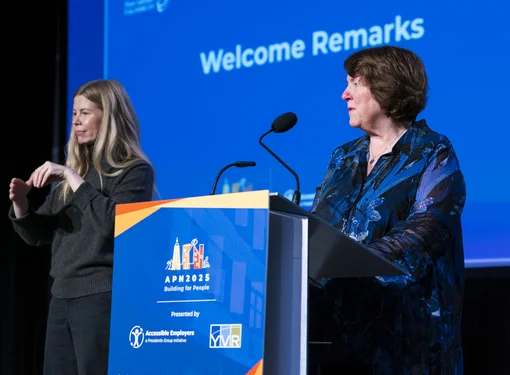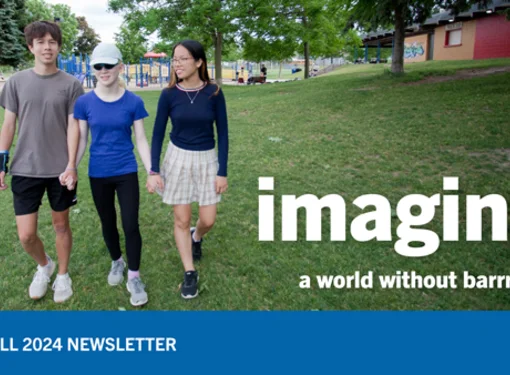Accessibility and inclusivity in Canada: A closer look
December 3 marks the International Day of Persons with Disabilities; a day celebrated around the world to increase awareness, understanding and acceptance of people with disabilities for a more inclusive world for all.
Each year, we use this day as an opportunity to celebrate how far we’ve come in breaking down barriers for people with disabilities, but also, to look forward and see how much more we need to do.
Again this year, we worked with the Angus Reid Institute to get a picture of how Canadians feel about important disability issues like social barriers for people with disabilities (including in the workplace) and accessibility within the built environment.
Disability in Canada: The numbers
There are a significant number of Canadians with physical disabilities: One in ten self-identify as having a disability, and even more (13%) say that while they don’t self-identify as having a disability, they do face mobility challenges that impact their day-to-day lives.
These Canadians face a variety of barriers every day, both physical ones like inaccessible buildings and public transit, and social ones, like stereotyping and discrimination. Seventy three percent of Canadians agree that there is a lot of prejudice towards people with physical disabilities.
With one in five Canadians expected to have a disability by 2036, we need to increase understanding around important disability issues, and change attitudes about people with disabilities that will allow them to live and work to their full potential.
What are Canadians’ thoughts about people with disabilities in the workplace?
Widespread and chronic unemployment and underemployment of people with disabilities was one of the key areas explored in the report.
When asked, fifty percent of Canadians believe that it’s understandable that employers feel it’s risky to hire people with disabilities. Two of main reasons they thought so? One, some tasks may be too difficult for people with disabilities and two, it would be too expensive to make the workplace accessible. While these two reasons are common presumptions, it’s been proven that both are largely myths, and not facts. Let’s take a closer look.
When given reasonable accommodation (e.g., adjustable desks, screen readers, JAWS software), people with disabilities can work just as effectively as those without disabilities. In fact, 90 percent of people with disabilities rated average or better on job performance.
And although many people think the cost of accommodating a person with disabilities is prohibitive, in reality, workplace accommodations are usually very affordable, with a typical one-time cost of only $500.
It’s important to break down these kinds of myths so that employers aren’t discouraged from working people with disabilities.
Accessibility in Canada
While 9 out of 10 Canadians think accessibility is a human right, they see large gaps between how accessible buildings are right now and how accessible they should be.
Eighty-eight percent of those surveyed believe Canada should be a world leader in ensuring universal access to public places, and ninety-five percent of Canadians also believe that accessibility is very important consideration when planning for new construction.
Most Canadians see that the way buildings are constructed as a major obstacle to accessibility and eighty-six percent of Canadians think that a LEED-style of program to rate how accessible a building is would be worthwhile to implement.
Currently many buildings and public spaces are not accessible for a significant number of people and this problem will only get worse as the percentage of Canadians with disabilities and our aging population continues to grow.
This accessibility gap motivated us to create the Rick Hansen Foundation Accessibility Certification Program, a program that is currently being designed to make the built environment in Canada accessible for people of all abilities. This includes people who have mobility challenges, are blind or have low vision, or are Deaf or hard of hearing.
Our program, which when completed will be the only one in Canada, will help people planning, designing, and constructing the built environment understand accessibility from the perspective of people with disabilities, and measure the accessibility of their venues using a consistent methodology. It’s our hope that this program will work to decrease the accessibility gap and make every community in Canada accessible for everyone.
What can you do to help accessibility and inclusivity in Canada?
It’s easy! Share this post with your family and friends and have a conversation about these disability issues. Awareness and education are the best ways to break down stereotypes and common misconceptions about people with disabilities.
Talk to your colleagues and human resources department about implementing an inclusive hiring policy at your workplace. Once employers (and other employees) start to engage with people with disabilities in the workplace, preconceived negative ideas about hiring and working with people with disabilities can be overcome.
Identify and break down barriers in your community. Our Access4All Canada 150 Signature Initiative is providing grants of up to $30,000 toward accessibility infrastructure projects and associated awareness events in schools and communities across our country. Projects can include adding ramps to building entrances, installing elevators or accessible washrooms, creating accessible way finding, or updating playgrounds to be accessible.
By having conversations, creating awareness, and taking positive steps towards full accessibility, we can have a truly inclusive Canada.
***
View the full 2016 Angus Reid Institute Report, Disability in Canada: Does closing the accessibility gap literally start from the ground up? (PDF)
View the full report in French. (PDF)
Request the accessible Word version of the report (English and French) by emailing info@rickhansen.com.






